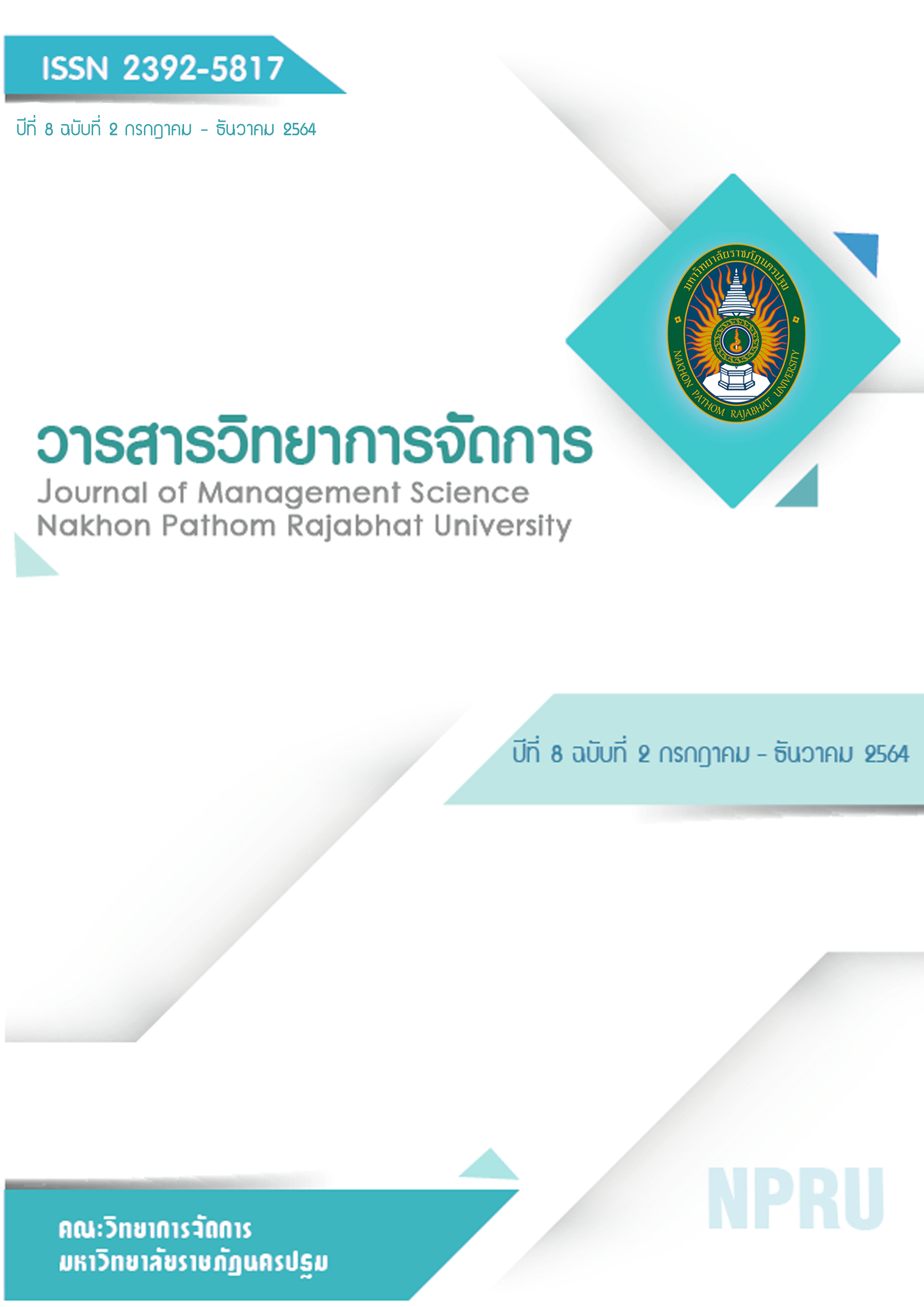Developing an Environmental Health Model for Health Tourism Destinations and Sustainability in Western Thailand
Main Article Content
Abstract
The objectives of this research are 1) to study environmental health characteristics of health tourism destinations in the western region 2) to study factors affecting environmental health characteristics of health tourism destinations in the western region 3) to study the satisfaction of tourists on environmental health factors of health tourism destinations in the western region and 4) to develop the environmental health model in the health tourism destinations.
A mixed method was applied for data collecting. This research was divided into 4 phase. The first and the second phase were qualitative research. In-depth interview and focus group were used for studying environmental health with 50 stakeholders. The third phase was to studied tourists' satisfaction with 358 tourists. The fourth phase was to develop the model and test it.
This research found that, the environmental health in health tourism destinations is characterized by the appropriateness of destinations’ context. It consists of 7 environmental health factors, including 1) food sanitation, 2) supply of drinking water, 3) solid waste management, 4) toilet management, 5) waste water disposal, 6) management accommodation and 7) safety health tourism. This research selected 5 health tourism routes in the western region, namely Route 1, Pala U Community, Prachuap Khiri Khan Province, Route 2, Nong Ya Plong Community, Petchaburi Province, Route 3, Ban Nong Rong Community, Kanchanaburi Province, Route 4, Lao Stud Community Klak, Ratchaburi Province, Route 5, Mahasawat Canal Community, Nakhon Pathom Province. Tourists were satisfied with the environmental health management in the medium to high levels. Which the 5 selected places. most of the places do not have a good accommodation service and some places have a homestay which managed by the house owner and depends on the owner's decision. the test is to evaluate 6 aspects in total of 25 issues. A model of the environmental health will lead 5 tourism destinations to be the sustainable health tourism destinations if they develop and improve the environmental health management in 25 issues, including 141 practices.
Article history : Received 9 May 2020
Revised 10 August 2020
Accepted 14 August 2020
SIMILARITY INDEX = 2.97 %
Article Details
The views and opinions of the article appearing in this journal are those of the author. It is not considered a view and responsibility of the editorial staff.
References
กรมการท่องเที่ยว กระทรวงการท่องเที่ยวและกีฬา. (2558). ยุทธศาสตร์การท่องเที่ยวไทยปี 2558-2560. กรุงเทพฯ: กระทรวงการท่องเที่ยวและกีฬา.
กรมอนามัย. (2556). เกณฑ์มาตรฐานส้วมสาธารณะระดับประเทศ. [ออนไลน์]. สืบค้นเมื่อ 29 ตุลาคม 2559, จาก http://203.157.186.111/scm/docs/3609/HAS.pdf.
การท่องเที่ยวแห่งประเทศไทย. (2539). นโยบายและแนวทางการพัฒนาการท่องเที่ยวเชิงอนุรักษ์ พ.ศ. 2539-2540. กรุงเทพฯ: กองนโยบาย และแผนการท่องเที่ยวแห่งประเทศไทย.
การท่องเที่ยวแห่งประเทศไทย. (2555). ความสำคัญของการบริหารจัดการการท่องเที่ยวอย่างยั่งยืน. [ออนไลน์]. สืบค้นเมื่อ 29 สิงหาคม 2559, จาก http://www.etatjournal.com/web/menu-read-web-etatjournal/menu-2012/menu-2012-apr-jun/449-22555-travel.
กุลวดี แกล้วกล้า. (2550). พฤติกรรมการท่องเที่ยวของข้าราชการเกษียณอายุ. กรุงเทพฯ : มหาวิทยาลัยมหิดล.
จินต์จุฑา แสงเพชร. (2554). การจัดการอนามัยสิ่งแวดล้อมของแหล่งท่องเที่ยวในจังหวัดชัยภูมิ. วารสารวิจัยสาธารณสุขศาสตร์ มหาวิทยาลัยขอนแก่น, 3, 87-96.
นาวีน บุตรคำชิต. (2550). รูปแบบการดำเนินงานสุขาภิบาลอาหารในแหล่งท่องเที่ยว ตามโครงการอาหารสะอาด รสชาติอร่อย : กรณีศึกษา อุทยานแห่งชาติภูกระดึง. วิทยานิพนธ์ปริญญาสาธารณสุขศาสตรมหาบัณฑิต. ขอนแก่น: บัณฑิตวิทยาลัยมหาวิทยาลัยขอนแก่น.
ปราณี ไพบูลย์สมบัติ. 2546. ชนิดและปริมาณ ขยะและพฤติกรรมการทิ้งขยะของนักท่องเที่ยวและผู้ประกอบการในอุทยานแห่งชาติเขาใหญ่. วิทยานิพนธ์ปริญญาวิทยาศาสตรมหาบัณฑิต. กรุงเทพฯ: บัณฑิตวิทยาลัยมหาวิทยาลัยเกษตรศาสตร์.
ศรัณพร ชวนเกริกกุล. (2553). การสื่อสารและภาพลักษณ์ด้านการท่องเที่ยวของกรุงเทพมหานคร. กรุงเทพฯ : มหาวิทยาลัยเกริก.
ศุภชัย ปิดตานัง. (2555). รูปแบบการดำเนินงานสุขาภิบาลร้านอาหาร โดยกระบวนการมีส่วนร่วมสู่มาตรฐาน อาหารสะอาดรสชาติอร่อย. วารสารราชพฤกษ์, 10 (1), 65-70.
สำนักสุขาภิบาลอาหารและน้ำ. (2557). คู่มือการปฏิบัติงานด้านสุขาภิบาลอาหารและน้ำ สำหรับสาธารณสุขอำเภอ: ข้อกำหนดมาตรฐานด้านสุขาภิบาลอาหาร. กรุงเทพฯ: ชุมนุมสหกรณ์การเกษตรแห่งประเทศไทย.
สำนักอนามัยสิ่งแวดล้อม. (2558). คู่มือวิชาการอนามัยสิ่งแวดล้อมพื้นฐาน สำหรับเจ้าพนักงานสาธารณสุขตามพระราชบัญญัติการสาธารณสุข พ.ศ. 2535. กรุงเทพฯ: แก้วเจ้าจอม มหาวิทยาลัยราชภัฏสวนสุนันทา.
สุภางค์ จันทวานิช. (2546). การวิเคราะห์ข้อมูลในการวิจัยเชิงคุณภาพ. (พิมพ์ครั้งที่ 5). กรุงเทพ: สำนักพิมพ์แห่งจุฬาลงกรณ์มหาวิทยาลัย.
อริศรา ห้องทรัพย์. (2557). แนวทางการจัดการท่องเที่ยวเชิงสุขภาพแหล่งน้ำพุร้อนในภูมิภาคทางตอนเหนือของประเทศไทย. วิทยานิพนธ์ปริญญาวิทยาศาสตรมหาบัณฑิต สาขาวิชาวิทยาศาสตร์การกีฬา. บัณฑิตวิทยาลัย.จุฬาลงกรณ์มหาวิทยาลัย.
Dickman, S. (1996). Tourism: An introductory text (2nd ed.). Melbourne: Hodder Education
Keeves, J. B. (1988). Models and model building. In J. P. Keeves, (Ed.), Educational Research Methodology, Approach. New York: McGraw-Hill.

